MODULE 1
Analog modulation
The basic process of exchanging information or data is communication.
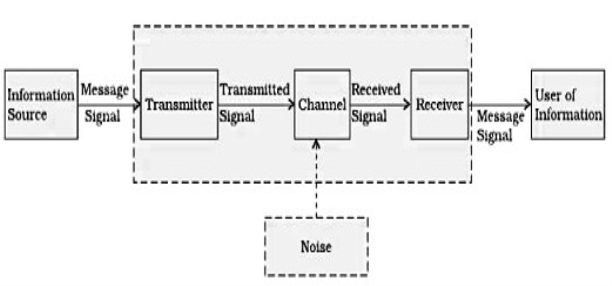
The elements of basic communication system are as follows
• Information or signal
• Input Transducer
• Transmitter
• Communication channel or medium
• Noise
• Receiver
• Output Transducer
1. Information or signal
• The communication systems are developed for transferring and receiving helpful information from one place to different.
• The information may be within the style of sound signal like speech or music or it may be within the style of photos.
2. Input Transducer
• The information within the style of sound, image or signals cannot the transmitted as it is.
• First the information or signals has to be converted into an appropriate electrical signal.
• The input transducers unremarkably utilized in the communication systems are microphones, TV etc.
3. Transmitter
• The operation of the transmitter block is to convert the electrical equivalent of the data to an appropriate form.
• It will increase the power of the signal, so that it can cover the large range. Amplifiers, mixer, oscillator, and power amplifier are the electronic circuits which are used as transmitter.
4. Channel or medium
• The channel is that the medium used for the transmission of electronic signals from one place to another.
• The communication medium may be conducting wires, cables, optical fibres or free space. 2 forms of the communication system can exist depending upon type of medium
a. Wire communication or line communication
b. Wireless communication or radio communication
5. Noise
• When suitable form electrical Signal travels from transmitter to receiver, an unwanted signal gets added into it known as noise signal.
• Due to noise, the standard of the transmitted info can degrade. One supplementary the noise can't be separated out from the data
• Hence noise is a massive downside or problem within the communication systems.
6. Receiver
• The exactly opposite process of transmission is reception. The received signal is amplified and demodulated and converted into an appropriate form.
• Mixer, oscillator, detector and amplifier are the electronic circuits used as receiver.
7. Output electrical device
• It consists of the electrical signal at the output of the receiver back to the initial kind of signal i.e. sound or photos.
• The typical example of the output transducers are loud speakers, pic tubes etc.
Modulation and Its Classification
A signal carrying data or message should get transmitted over a distance and for this to establish a reliable communication, it needs to take the help of signal with high frequency which should not affect the original characteristics of information signal.
The characteristics of the message signal, if changed, the message contained in it conjointly alters. Hence, it's a requirement to take care of the message signal. A high frequency signal will travel up to an extended distance, without getting affected by noise. Transmitting the message signal with the help of such high frequency signal called as carrier signal is known as Modulation.
Modulation is that the method of changing the amplitude, frequency and phase of the carrier signal with respect to amplitude of modulating signal.
Need of Modulation
Baseband signals or Message signals don't seem to be compatible for transmission mechanism. To make this signal compatible and to travel longer distance, the strength of the signal should be raised by modulation with high frequency carrier signal, without affecting the parameters of baseband/modulating signal.
Advantages of Modulation:
• Avoid mixing of signals
• Increases range of communication
• Multiplexing of signals is feasible
• Improves quality of reception
• Reduces Height of Antenna
Signals in the Modulation Process:
There are three types of signals in modulation process
Message or Baseband or Modulating Signal:
Message signals are the signals which contains information or message. To transmit this baseband signal first modulation process is to be done on this signal before transmission. Hence known as modulating Signal.
Carrier Signal
This signals do not contain any information i.e., it is empty signal. It is high frequency signal to carry the modulating signal after modulation.
Modulated Signal
The signal which gets after modulation process is known as modulated signal. This signal is combination of modulating signal and carrier signal.
Classification of Modulation:
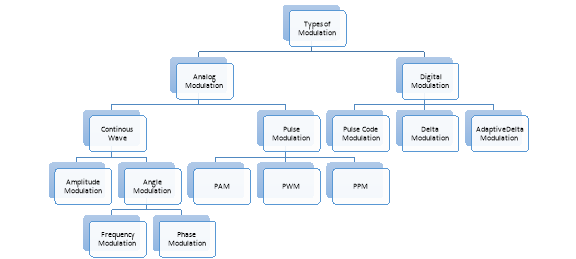
Figure 1
Types of modulation are as shown in fig1. Primarily there are 2 types of modulation.
- Analog Modulation
- Digital Modulation
Analog Modulation:
In analog modulation Continuous wave or periodic sequence is used as carrier signal. According to this Analog Modulation is further divided into Continuous wave and Pulse modulation
Digital Modulation:
In digital modulation signals are in 0s and 1s form. The modulation technique used in digital type are Pulse Code Modulation (PCM), Delta Modulation (DM) and Adaptive Delta Modulation.
Low frequency baseband signals like an audio, TV signals transferring over a high frequency carrier signal such as a radio frequency band is the process of analog modulation. In this modulation message signal is always analog in nature.
There are 3 properties of a carrier signal amplitude, frequency and phase thus there are three basic types of analog modulations.
- Amplitude Modulation (AM)
- Frequency Modulation (FM)
- Phase modulation (PM)
According to the definition, “The amplitude of the carrier signal varies in accordance with the instantaneous amplitude of the modulating signal.” Which means, the amplitude of the carrier signal which are empty varies as per the amplitude of the signal containing information, at each instant. This is explained in the following wave forms.
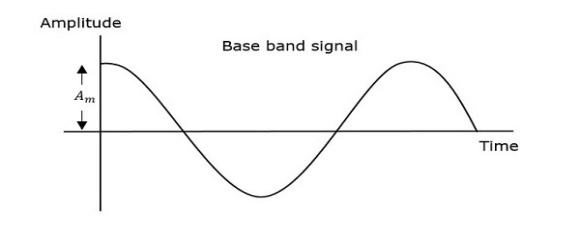

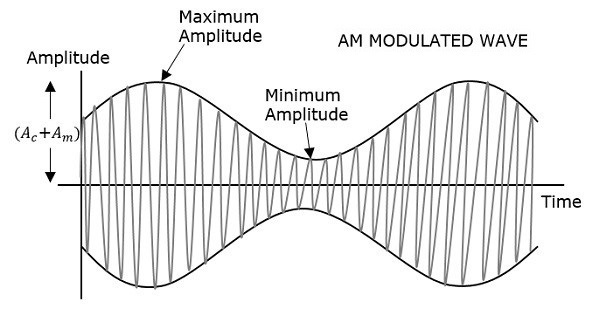
The first wave form shows the modulating wave, which contains the message/information signal. The second one is the carrier wave, which is a high frequency signal and contains no information. While, the third one is the resultant modulated wave.
From above wave form we can see that the positive and negative peaks of the carrier wave, are interconnected with an imaginary line. This line is the exact shape of the modulating signal. This imaginary line on the carrier wave is an Envelope. It is the nothing but as the message signal.
Mathematical Expressions
The mathematical expression is
Let the modulating/message signal be,
m (t)=Amcos (2πfmt)
And the carrier signal be,
c (t)=Accos (2πfct)
Where,
Am: Amplitude of modulating signal and
Ac: the amplitude of the carrier signal.
Fm: frequency of the modulating signal and
Fc: frequency of the carrier signal.
According to the definition of AM, We change the amplitude of carrier signal,
s (t)= [Ac+ m(t)] cos(2πfct)
s (t)= [Ac+Amcos(2πfmt)]cos(2πfct) … (1)
Modulation Index
A Measure of extent of modulation done on carrier signal is called as Modulation Index. It is the ratio of the amplitude of modulating signal to that of the carrier signal. From equation (1), taking Ac common,
s (t)=Ac[1+(Am/Ac)cos(2πfmt)]cos(2πfct)
s (t)=Ac[1+mcos(2πfmt)]cos(2πfct) … (2)
Where, Modulation index m is equal to the ratio of Am and Ac. Mathematically, we can write it as
m= Am/Ac … (3)
Hence, if we know the amplitude of carrier and message signal, we can calculate the modulation index using above formula.
Now, if the maximum and minimum amplitudes of the modulated wave are known, let’s derive another formula for modulation index.
Let Amax: maximum amplitude of modulated wave
Amin: minimum amplitude of modulated wave.
When cos (2πfmt) = 1 then we will get the maximum amplitude of the modulated wave,
Amax=Ac+Am … (4)
When cos (2πfmt) = -1 then we will get the minimum amplitude of the modulated wave,
Amin=Ac−Am --- (5)
Let add (4) + (5),
Amax+Amin=Ac+Am+Ac−Am=2Ac
Ac = (Amax+Amin) / 2 --- (6)
Let substract (4) – (5),
Amax−Amin=Ac+Am− (Ac−Am) =2Am
Am = (Amax - Amin) / 2 --- (7)
The ratio of (7) and (6)
 =
= 
m =  … (8)
… (8)
Therefore, from (3) and (8) can calculate the Modulation index.
For a perfect modulation, the value of modulation index should be 1, which gives percentage of modulation should be 100%.
For instance, if this value is less than 1 ie m < 1, then the modulated output is Under-modulation as shown in fig below. This wave is known as an under-modulated wave.

If the modulation index m > 1, then the wave formed will be an over-modulated wave as shown in fig below.

This an over-modulated wave causes interference, which is difficult to eliminate that interference.
Bandwidth of AM Wave
The difference between the highest and lowest frequencies of the signal is known as Bandwidth (BW). It is given by,
BW=fmax−fmin
Consider eq. (1) of AM,
s(t)=Ac[1+μcos(2πfmt)]cos(2πfct)
s(t)=Accos(2πfct)+Acμcos(2πfct)cos(2πfmt)


 s(t)=Accos(2πfct)+Acμ2cos[2π(fc+fm)t]+Acμ2cos[2π(fc−fm)t]
s(t)=Accos(2πfct)+Acμ2cos[2π(fc+fm)t]+Acμ2cos[2π(fc−fm)t]
Hence, the AM wave has three frequencies. Those are carrier frequency fc, upper sideband frequency fc+fm and lower sideband frequency fc−fm.
Here,
Fmax = fc + fm and fmin = fc − fm
Therefore BW becomes,
BW=fc+fm −(fc−fm)
BW=2fm
Thus, Bandwidth is nothing but twice modulating frequency.
Power Calculations of AM Wave
Consider the equation of AM wave,
s(t)=Accos(2πfct)+  cos[2π(fc+fm)t]+ )+ )+
cos[2π(fc+fm)t]+ )+ )+  cos[2π(fc−fm)t]
cos[2π(fc−fm)t]
The sum of the all powers ie powers of carrier, upper sideband, and lower sideband frequency components gives the total power of AM waves.
Pt= Pc + PUSB + PLSB
We know that power is
P=vrms2 /R
= (vm / )2 / 2
)2 / 2
Firstly find the powers of the carrier wave Pc, the upper sideband PUSB and lower sideband PLSB one by one.
Carrier power
Pc= (Ac / )2/ R = Ac2 /2R
)2/ R = Ac2 /2R
Upper sideband power
PUSB = (Acm / )2 / R
)2 / R
= Ac2m2 / 8R
Similarly, lower sideband power is same as that of the upper side band power.
PLSB= Ac2m2 / 8R
By adding all powers,
Pt= Ac2 /2R + Ac2m2 / 8R + Ac2m2 / 8R
Pt= Ac2 /2R (1 + m2/4 + m2/4)
Pt = Pc (1 + m2/2)
When the carrier power Pc and the modulation index m are known, we can find the Power of AM using above formula.
If m=1, the power of AM wave is equal to 1.5 times the carrier power. So, the power required to transmit an AM wave is 1.5 times Pc for a perfect modulation.
Advantage of AM
It is simplest modulation.
Transmitter and receiver circuit is very simple and less cost effective.
Disadvantage of AM
AM is very susceptible to noise.
Application
AM radio Broad cast
Problem 1
A modulating signal m (t) =10cos (2π×103t) is amplitude modulated with a carrier signal c (t) =50cos (2π×105t) c (t). Find the modulation index m, the carrier power Pc, and the power required for transmitting AM wave Pt.
Solution
Given, the equation of modulating signal as
m (t)=10cos(2π×103t)
We know that standard equation of modulating signal as
m (t)=Amcos(2πfmt)
Given, the equation of carrier signal is
c (t)=50cos(2π×105t)
The standard equation of carrier signal is
c (t)=Accos(2πfct)
By comparing these two equations, we will get
Amplitude of carrier signal as Ac=50volts
And Frequency of carrier signal as fc = 105Hz = 100KHz
We know the formula for modulation index as
m=Am /Ac
m=10/50=0.2
Therefore, the value of modulation index m = 0.2 and percentage of modulation is 20%.
The formula for Carrier power, Pc is
Pc= Ac2 /2R
Assume R=1Ω and substitute Ac value in the above formula.
Pc= (50)2/ (2*1) =1250W
Therefore, the Carrier power, Pc is 1250 watts.
We know that power required for transmitting AM wave is
Pt = Pc (1 + m2/2)
Pt=1250(1+ (0.2)2/2) =1275W
Therefore, the power required for transmitting AM wave Pt = 1275 watts.
In Amplitude Modulation, the modulated wave consists of the carrier wave and two sidebands. Carrier wave doesn’t contain any information or message. The information is present only in the sidebands. Sideband is a band of frequencies, which contains power which are the lower and higher frequencies of the carrier frequency.
In double sideband full carrier system DSBFC, the transmission of carrier signal along with two sideband takes place. It is drawn as shown in figure below.

However, such a transmission is inefficient. Because, (2/3) rd of the power is being wasted in the carrier, which carries no information.
If this carrier signal is suppressed and the saved power is utilized by the two sidebands, then such a process is called as Double Sideband Suppressed Carrier system i.e., DSBSC. It is as shown in the following figure.
 DSBSC Wave Forms
DSBSC Wave Forms

Mathematical Expression
Let us consider the same modulating and carrier signals as we have considered in Amplitude Modulation
i.e., Modulating signal: m (t) =Amcos (2πfmt)
Carrier signal: c (t) =Accos (2πfct)
Therefore, equation of DSBSC wave is nothing but product of modulating and carrier wave
s(t)=m(t)c(t)
s(t)=AmAccos(2πfmt)cos(2πfct)
Bandwidth of DSBSC:
We know that Bandwidth is,
BW=fmax−fmin
And equation of DSBSC is,
s(t)=AmAccos(2πfmt)cos(2πfct)
s(t)= cos[2π(fc+fm)t]+
cos[2π(fc+fm)t]+ cos[2π(fc−fm)t]
cos[2π(fc−fm)t]
From above equation we can say that DSBSC signal has two frequencies in which maximum frequency is fc+fm and minimum frequency is fc−fm.
Putting the value of fmax and fmin in bandwidth, we get,
BW=fmax −fmin
BW=fc+fm − (fc−fm)
BW=2fm
This bandwidth is same as that of AM wave ie twice of modulating frequency.
Power Calculation of DSBSC
The equation of DSBSC wave is,
s(t)= cos[2π(fc+fm)t]+
cos[2π(fc+fm)t]+ cos[2π(fc−fm)t]
cos[2π(fc−fm)t]
Total power of DSBSC wave is the addition of power of upper sideband and power of lower sideband.
Pt = PUSB + PLSB
We know that power is
P=vrms2 /R
= (vm / )2 / 2
)2 / 2
Upper sideband power
PUSB = (Acm / )2 / R
)2 / R
= Ac2m2 / 8R
Similarly, lower sideband power is same as that of the upper side band power.
PLSB= Ac2m2 / 8R
By adding all powers,
Pt= Ac2m2 / 8R + Ac2m2 / 8R
Pt= 2 (Ac2m2 / 8R)
Pt = Ac2m2 / 4R
The two sidebands of DSBSC modulated signal contains same information. So, transmission of one sideband is also sufficient to transmit the complete information from source to destination. We can eliminate one sideband.
To eliminate one sideband along with carrier, the suppressing process is used. Transmission of a single sideband is called as Single Sideband Suppressed Carrier system or simply SSBSC. It is as shown in the figure below,

From fig we can say that carrier and lower sideband are suppressed and upper sideband is transmitted. By the same way we can suppress the carrier and upper sideband and lower sideband is transmitted.
SSBSC system transmit single sideband with high power as power of carrier and other sideband is used/utilized by single sideband.
Mathematical Expression:
The modulating and carrier signal we have,
m(t)=Amcos(2πfmt)
And
c(t)=Accos(2πfct)
The equation for SSBSC is,
s(t)= cos[2π(fc+fm)t] …for upper sideband
cos[2π(fc+fm)t] …for upper sideband
OR
s(t)= cos[2π(fc−fm)t] …for lower sideband
cos[2π(fc−fm)t] …for lower sideband
Bandwidth of SSBSC
As SSBSC modulated wave contains only one sideband therefore bandwidth is half of DSBSC modulated wave.
Bandwidth of SSBSC modulated wave = 2fm/2 = fm.
Power calculation of SSBSC
The equation for SSBSC is,
s(t)= cos[2π(fc+fm)t] …for upper sideband
cos[2π(fc+fm)t] …for upper sideband
Or
s(t)= cos[2π(fc−fm)t] …for lower sideband
cos[2π(fc−fm)t] …for lower sideband
As it contains only one sideband, power of SSBSC is nothing but power of any one sideband frequency component.
Pt = PUSB = PLSB
We know that power is
P=vrms2 /R
= (vm / )2 / 2
)2 / 2
Upper sideband power
PUSB = (Acm / )2 / R
)2 / R
= Ac2m2 / 8R
Similarly, lower sideband power is same as that of the upper side band power.
PLSB= Ac2m2 / 8R
Therefore power of DSBSC wave is,
Pt = PUSB = PLSB = Ac2m2 / 8R
Advantages
- Bandwidth is less than AM and DSBSC waves.
- Transmission of more number of signals is allowed.
- Power is saved.
- High power signal can be transmitted.
- Less amount of noise is present.
- Signal fading is less likely to occur.
Disadvantages
- The generation and detection circuit of SSBSC wave is a complex process.
- The quality of the signal gets affected unless the SSB transmitter and receiver have an excellent frequency stability.
Applications
- For power saving requirements and low bandwidth requirements.
- In land, air, and maritime mobile communications.
- In point-to-point communications.
- In radio communications.
- In television, telemetry, and radar communications.
- In military communications, such as amateur radio, etc.
In SSBSC we have seen that only one sideband frequency can transmit the data. Theoretically, by using ideal pass filter, we can get one sideband frequency component. But, practically while getting the entire sideband frequency some information gets lost.
To avoid this loss, a technique is derived, which is a compromise between DSBSC and SSBSC. This technique is called as Vestigial Side Band Suppressed Carrier (VSBSC) technique. In this, the word “vestige” means “a part” from which, the name is derived.
Where a part of the signal i.e. vestige is modulated along with one sideband is known as VSBSC Modulation. The frequency spectrum of VSBSC wave is given in fig.

Along with one sideband i.e. the upper sideband, a part of the other sideband here lower sideband is also being transmitted in this technique. Similarly, vice versa can occur. To avoid the interference, a guard band of very small width is laid on either side of VSB. The most common application of VSB modulation is in television transmissions.
Bandwidth of VSBSC Modulation
We know that the bandwidth of SSBSC modulated wave is fm. As the VSBSC modulated wave contains the frequency components of one sideband along with the vestige of other sideband, the bandwidth of it will be the sum of the bandwidth of SSBSC modulated wave and vestige frequency fv
i.e., Bandwidth of VSBSC Modulated Wave = fm + fvfm +fv
Advantages
- Highly efficient.
- Reduction in bandwidth when compared to AM and DSBSC waves.
- Filter design is easy, since high accuracy is not needed.
- The transmission of low frequency components is possible, without any difficulty.
- Possesses good phase characteristics.
Disadvantages
- Bandwidth is more when compared to SSBSC wave.
- Demodulation is complex.
Applications
The most common and standard application of VSBSC is for the transmission of television signals.
AM transmitter takes the audio signal as an input and delivers amplitude modulated wave to the antenna as an output to be transmitted. The diagram of AM transmitter is shown within the following figure.
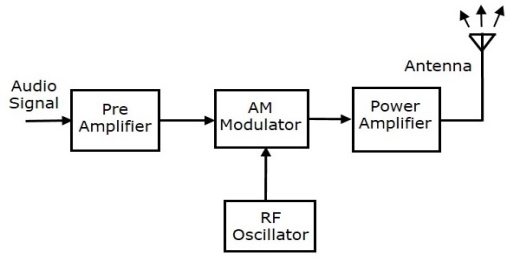
The working of AM transmitter are often explained as follows.
- The audio signal from the output of the microphone is sent to the pre-amplifier, which boosts the level of the modulating signal.
- The RF oscillator generates the carrier signal.
- Both the modulating and the carrier signal is sent to AM modulator.
- Power amplifier is used to increase the power levels of AM wave. This wave is finally passed to the antenna to be transmitted.
The AM super superheterodyne receiver takes the amplitude modulated wave as an input and produces the first audio signal as an output. Selectivity is that the ability of choosing a specific signal, while rejecting the others. Sensitivity is that the capacity of detecting RF signal and demodulating it, while at the lowest power level.
Radio amateurs are the initial radio receivers. However, they have drawbacks like poor sensitivity and selectivity. To overcome these drawbacks, superheterodyne receiver was invented. The diagram of AM receiver is shown within the following figure.

RF Tuner Section
The amplitude modulated wave received by the antenna is first passed to the tuner circuit through a transformer. The tuner circuit is nothing but a LC circuit, which is additionally called as resonant or circuit. It selects the frequency, desired by the AM receiver. It also tunes the oscillator and therefore the RF filter at a similar time.
RF Mixer
The signal from the tuner output is transferred to the RF-IF converter, which acts as a mixer. It has a local oscillator, which produces a constant frequency. The mixing process is completed here, having the received signal as one input and therefore the oscillator frequency as the other input. The resultant output is a mixture of two frequencies [(f1+f2), (f1−f2)] produced by the mixer, which is called as the Intermediate Frequency (IF).
The production of IF helps within the demodulation of any station signal having any carrier frequency. Hence, all signals are translated to carrier frequency for adequate selectivity.
IF Filter
Intermediate frequency filter is nothing but band pass filter, which passes the required frequency. It eliminates all other unwanted frequency components present in it. This is the advantage of IF filter, which allows Inter Mediate (IF) frequency.
AM Demodulator
The received AM wave is now demodulated using AM demodulator. This demodulator uses the envelope detection process to receive the modulating signal.
Audio Amplifier
This stage is the power amplifier stage, which is used to amplify the detected audio signal. The processed signal is strengthened to be effective. This signal is passed on to the loudspeaker to get the original sound signal.
Reference Books:
- Kennedy G, ‘Electronic Communication System’, McGraw Hill, 1987.
- Dr. Sanjay Sharma, “Communication System (Analog and Digital)”, Katson Books.